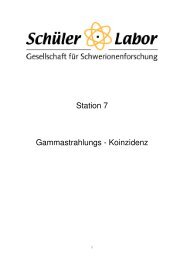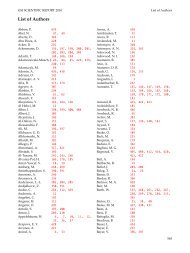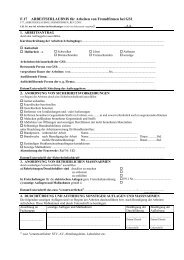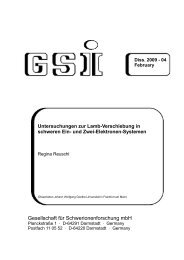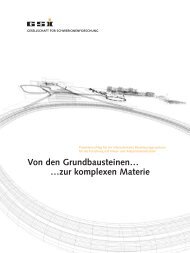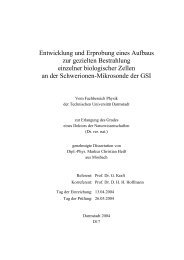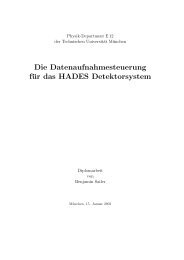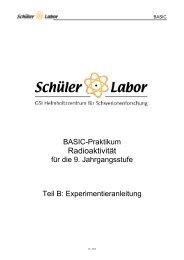CBM Progress Report 2006 - GSI
CBM Progress Report 2006 - GSI
CBM Progress Report 2006 - GSI
Create successful ePaper yourself
Turn your PDF publications into a flip-book with our unique Google optimized e-Paper software.
<strong>CBM</strong> <strong>Progress</strong> <strong>Report</strong> <strong>2006</strong> FEE and DAQ<br />
An ASIC based fast Preamplifier-Discriminator (PADI) for MRPCs ∗<br />
M.Ciobanu 1,2 , A.Schüttauf 1 , E.Cordier 2 , N.Herrmann 2 , K.D.Hildenbrand 1 , Y.J.Kim 1 , M.Kiˇs 1 ,<br />
P.Koczon 1 , Y.Leifels 1 , X.Lopez 1 , M.Marquardt 1 , J.Weinert 1 , and X.Zhang 1<br />
1 <strong>GSI</strong>, Darmstadt, Germany; 2 Universität Heidelberg, Germany<br />
The use of conventional integrated circuits to process<br />
primary RPC signals has reached its limit with designs<br />
like FOPI’s 16 channel FEE5 [3]. To further reduce the<br />
price and power consumption per channel the natural way<br />
is a custom ASIC design. For this purpose the NINO<br />
architecture [1] used in the ALICE-ToF with its full<br />
differential structure offers a very attractive starting point<br />
for a new Preamplifier-Discriminator design.<br />
Figure 1: Asic Layout of the PADI chip with 3 channels<br />
Taking into account the existing ideas of time measurements<br />
with fast gas detectors with up to 100000<br />
channels within the <strong>CBM</strong>-detector at the FAIR-facility<br />
of <strong>GSI</strong>, we started to investigate, within the European<br />
project JRA-12, the development a new 4 channel PADI-<br />
ASIC in CMOS 0.18 µm technology. This chip has<br />
the following key parameters: fully differential, 50 Ω<br />
input impedance, LVDS compatible output, preamplifier<br />
gain G ≥ 200, preamplifier bandwidth BW ≥ 400<br />
MHz, peaking time tP ≤ 1ns, noise related to input<br />
σn ≤ 25µV RMS, comparator gain G ≥ 200, a DC<br />
feedback loop for offset and threshold stabilization and a<br />
threshold range related to the input of ∆UThr ∼0.5-20 mV.<br />
Based on these characteristics we designed a first version<br />
of the PADI-Chip (Fig. 1), with 3 channels in its first prototype.<br />
With the first delivered samples we have performed<br />
tests to check the basic functionality (connections, voltage,<br />
in/outputs of time and charge, thresholds). From these elementary<br />
tests we conclude that all channels are fully operational.<br />
Due to this very positive result we designed a<br />
∗ work supported by JRA12 of EU/FP6 Hadronphysics (see annex),<br />
INTAS Ref.Nr. 03-54-3891 and German BMBF contract 06 HD190I.<br />
53<br />
PCB for the PADI-chip which is directly connected to our<br />
FOPI-digitizer TACQUILA3 [2].<br />
Figure 2: First timing measurement of the PADI-chip together<br />
with the TACQUILA-card. A time-resolution σt ≤<br />
10 ps has been reached for a single channel.<br />
The combined setup (PADI-TACQUILA3) has a timing<br />
performance of σt ≤ 10 ps for pulser signals above 20 mV<br />
(see Fig 2.). In the following measurements we will map<br />
out the overall time resolution as a function of the amplitude.<br />
We will also compare time-over-threshold (ToT) to<br />
the direct charge measurement, to learn whether the ToT<br />
measurement is applicable for the walk correction.<br />
References<br />
[1] F.Anghinolfi, P.Jarron, A.N.Martemiyanov, E.Usenko,<br />
H.Wenninger, M.C.S.Williams and A.Zichichi<br />
Nucl. Inst. and Methods A, Vol. 533, Issues 1-2, 1 November<br />
2004, 183-187<br />
[2] K.Koch, H.Hardel, R.Schulze, E.Badura and J.Hoffmann<br />
IEEE Transactions on Nuclear Science, Vol. 52, No. 3, June<br />
2005, 745-747<br />
[3] M.Ciobanu a,b , A.Schüttauf a , E.Cordier b , N.Herrmann b ,<br />
K.D.Hildenbrand a ,Y.J.Kim a , Y.Leifels a , M.Kis a ,<br />
P.Koczon a , X.Lopez a , M.Marquardt a , M.Petrovici c ,<br />
J.Weinert a ,X.Zhang a<br />
sub. to IEEE Transactions on Nuclear Science 2007



